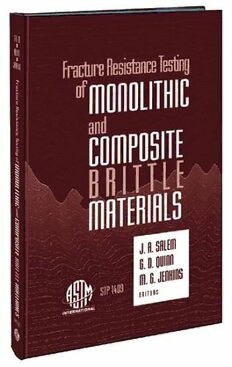
Fracture Resistance Testing of Monolithic and Composite Brittle Materials (ASTM Special Technical Publication, 1409) PDF
228 Pages·2002·4.656 MB·English
Most books are stored in the elastic cloud where traffic is expensive. For this reason, we have a limit on daily download.
Preview Fracture Resistance Testing of Monolithic and Composite Brittle Materials (ASTM Special Technical Publication, 1409)
Description:
STP 1409 features 14 peer-reviewed papers that summarize the latest methods for the measurement of fracture toughness, slow crack growth, and biaxial strength. It also identifies new areas for fracture toughness test methods development and standardization, such as testing of complex materials, elevated temperature measurement, and R-curve measurement. 5 sections cover: Plenary Session--discusses 30 years of progress in fracture mechanics of brittle materials. Implications For Design and Testing--focuses on the analysis of plates for biaxial strength testing and the transition in measured fracture toughness from a value associated with the properties of a single grain to the polycrystalline value. Fracture Toughness Standardization--examines 3 techniques that were developed and standardized as part of ASTM C 1421 Standard Test Methods for Determination of Fracture Toughness of Advanced Ceramics at Ambient Temperatures. These techniques show convergence when good metrology is employed. In addition to standardized techniques, this section discusses the single edged V-notched beam method that is on a fast track for standardization in Europe. Crack Growth Resistance--covers testing of functionally graded materials, elevated temperature R-curve testing, and the study of a toughening mechanism. Although most researchers applied classical mechanical techniques for the measurement of fracture toughness or crack growth resistance, both theoretical and fractographic methods were also presented. Unique Materials and Environmental Effects--examines elevated temperature fracture toughness testing of particulate reinforced ceramic composites, thermal and environmental effects on the fracture toughness of titanium carbonitrides for machining, and environmental interactions that lead to rate effects in "dynamic fatigue" (i.e., stress corrosion) testing. Audience: Mechanical Engineers • Ceramic Engineers • Materials Scientists • Designers
See more
The list of books you might like
Most books are stored in the elastic cloud where traffic is expensive. For this reason, we have a limit on daily download.
